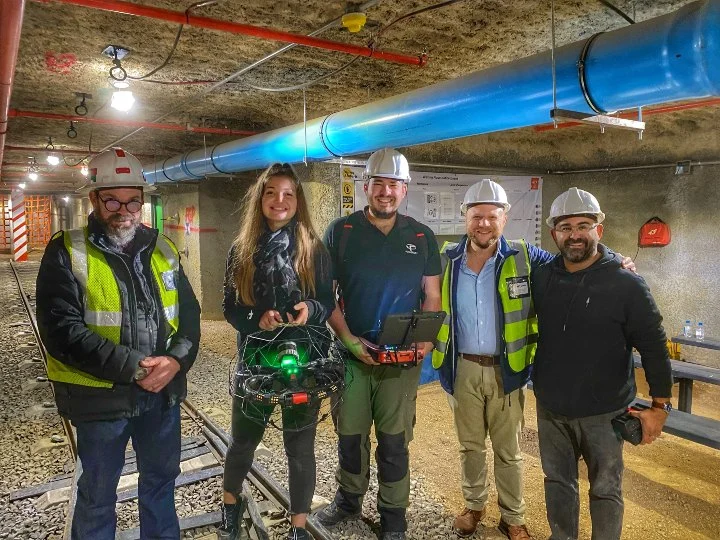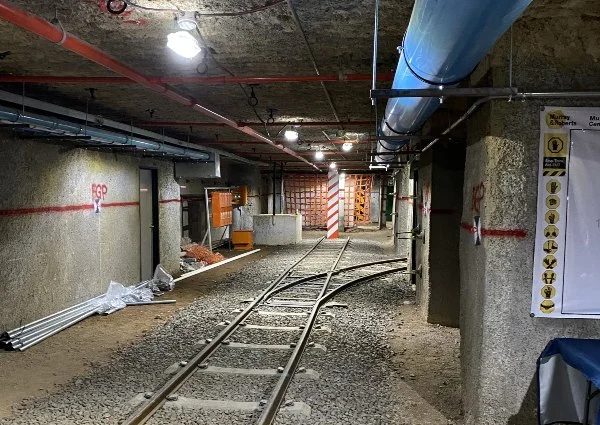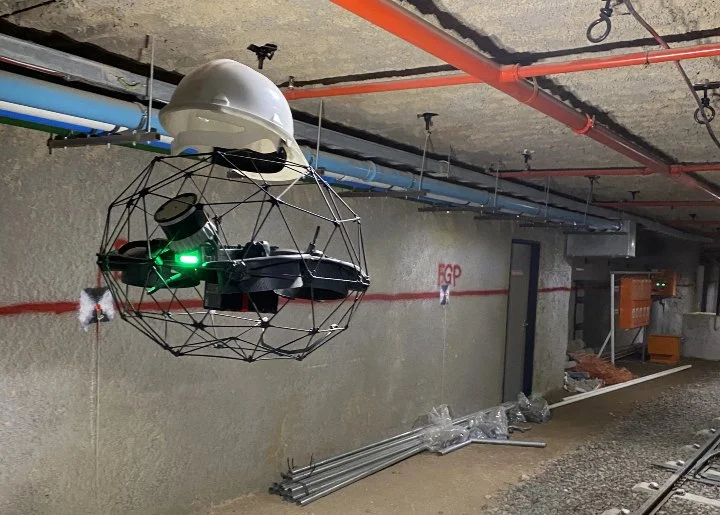Can you tell us about your journey in the mining sector in South Africa?
I graduated in 1991 with a degree in mine surveying from the Department of Mining Engineering and Mine Surveying at the University of Johannesburg. Here in South Africa, those working in mining must also earn a Government Certificate of Competency. After passing this exam in 1994, I worked in gold, nickel, and platinum mines for over a decade. In 2007, I transitioned to academia, returning to the University of Johannesburg where I initially received my education.

Professor Grobler with representatives from Flyability and GammaTec
What does the Mining Engineering and Mine Surveying Department at the University of Johannesburg do?
The Mining Engineering and Mine Surveying Department is celebrating its centenary in 2026, indicating its longstanding presence in the field. The department offers both Bachelor’s degrees in mining engineering and mine surveying. Following the undergraduate programs, students can pursue Honors and Master’s degrees. Annually, we train approximately 600 mining engineers and mine surveyors through our four degree programs. One of our key focuses is employability—most of our students either work in mines before joining our program or secure jobs in the industry post-graduation.
What unique facilities does the department offer?
About a decade ago, we constructed a tunnel on campus that functions as a simulation mine. This tunnel uses an existing basement with a shaft and replicates a typical mine layout. There are only a few such simulation mines worldwide. This facility is invaluable for undergraduate training, allowing students to gain practical experience without the constant need to visit active mines.

A view of the simulation mine
Additionally, we use the tunnel to test and demonstrate new technologies. Whether it's drones or robots, we can experiment with them in a controlled setting. We’ve already worked with Boston Dynamics’ Spot robot and Flyability’s Elios 3.
Furthermore, the department has developed a comprehensive virtual reality platform. Students can practice tasks such as placing explosives and conducting blasts in a virtual environment using a hydraulic drill rig and a blasting wall.
How are drones being used in mining?
Drones are primarily utilized for surveying and inspections in mining. According to regulations, surface plans must be updated every three to twelve months. A drone can assist in this process, reducing the need for surveyors to physically traverse hazardous terrain to collect data.
For inspections, drones can venture into unstable areas underground, collecting visual and LiDAR data. They can also investigate hangups and enhance our understanding of various subterranean zones.
What are the benefits of using drones in mining?
Two major advantages are safety and efficiency. Measuring volumes on the surface with drones saves significant time and minimizes risk exposure for surveying teams. Drones can remotely collect high-quality data from hard-to-reach or unstable areas underground, improving operational efficiency.
This single tool—a drone equipped with a single sensor—can provide valuable information to multiple professionals involved in mining operations, including mechanical engineers, shaft engineers, surveyors, and geologists. Safety is another key advantage. Recently, rescue workers perished in a mine due to extreme heat while searching for a missing person. With drones, we could have deployed them to assess the situation and temperature remotely before sending personnel into dangerous areas.
Mining in South Africa remains a vital industry employing about half a million people. Any technology that can save lives is highly valued. Remotely operated equipment like drones can play a crucial role in achieving this goal.
What concerns do you have regarding the use of drones in mining?
South Africa has stringent drone licensing requirements, yet some mining operations are using drones without proper licenses or trained pilots. Operating an unlicensed drone can lead to severe consequences, including fines and criminal charges from the Department of Mineral Resources.
Training is another concern. Many operators lack the necessary experience before using drones for work in mines. It’s important to emphasize that compliance with legal standards and proper training are essential. Just owning a consumer drone doesn’t qualify someone to use it for professional purposes in a mine.
How do you see Flyability’s Elios 3 benefiting mining operations?
The Elios 2 was the first Flyability drone I encountered. Its roll cage was particularly impressive as an anti-collision feature. However, the Elios 2 had stability issues, which are critical for surveyors. If a drone isn’t stable, the data it collects cannot be trusted.
These stability issues have been resolved with the Elios 3. It’s incredibly stable. During a recent test, we placed a hardhat on top of the drone, and it remained perfectly still.

The ability to rotate the camera vertically is another advantage of the Elios 3. We used it to identify survey points or pegs on the roof and walls of excavations by adjusting the camera angle.
How can mining operations benefit from an indoor drone with LiDAR sensing?
The inclusion of LiDAR on the Elios 3 transforms it from just an inspection drone to a mapping tool for inaccessible areas and block caving. It allows us to visualize the full dimensions of these spaces instantly. Compared to photogrammetry, LiDAR doesn’t require lighting and can penetrate dust and smog, which are common in mining environments. Visibility can drop below two meters in some mines, but LiDAR data remains effective regardless of these conditions.

The Elios 3's LiDAR sensor glowing green during a test flight
LiDAR enables real-time 3D mapping, allowing operators to navigate blind spots. It also captures textures and contacts, aiding in identifying geological hazards like faults and dykes. Hangup inspections in ore passes are another area where LiDAR proves beneficial, as it helps detect obstructions like mud or debris in vertical or near-vertical shafts.
What does the future hold for drones in South African mining?
Currently, the adoption of drones in mining is still in its early stages in South Africa. Some question whether drones and robots are merely solutions in search of problems, but I believe otherwise.
If we’re serious about improving mine safety, drones are essential. Drones are already proving their worth in the South African mining industry. No mine in the country operates without some form of drone technology on-site or nearby.
To fully integrate this technology, we need to promote broader adoption. Instead of hiring drone pilots as contractors for occasional inspections, each mining house should own at least one drone like Flyability’s Elios 3. Ideally, there would be multiple drones per site, allowing daily or weekly mapping of mine ends.
This technology has the potential to make mining safer and more efficient, and I’m excited to see how it evolves in the coming years."
" Oil Seal And Rings And Gasket, Sealing Ring Repair Kit Accessories,Oil Seal Package Accessories,Oil Pan Pad Accessories"
HONG KONG CRS INTERNATIONAL TRADING COMPANY LIMITED , https://www.crstrans.com
